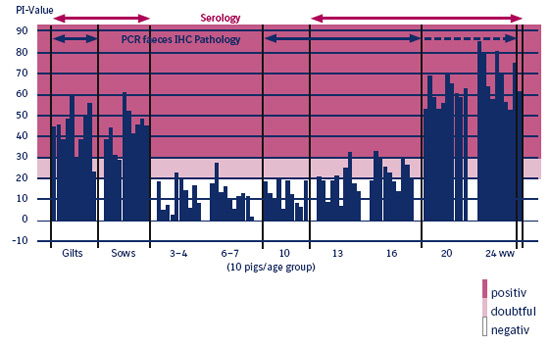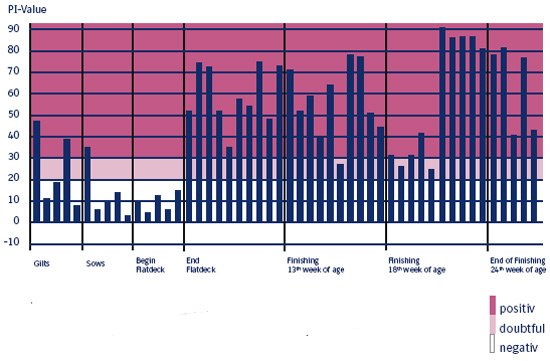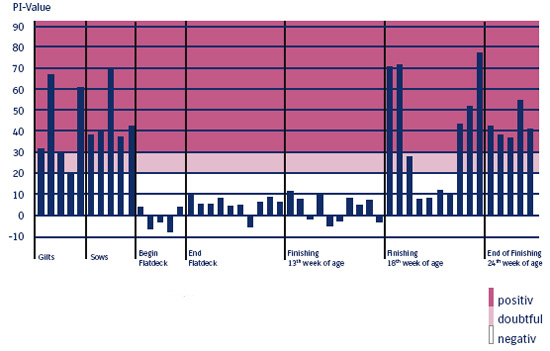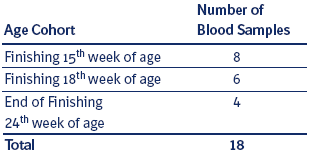5.3 How to interpret serological results?
Figure 5.3a shows a serological herd profile using a competitive ELISA (cELISA) for the detection of antibodies against Lawsonia intracellularis. Usually seroconversion can be detected between 16 and 24 weeks of age (ww) by an increasing percentage of inhibition (PI). However, under distinct herd structure and management situations, seroconversion can occur earlier in production. It is important to consider the risk of an acute Ileitis outbreak, which can cause deaths, when integrating gilts into farms. Here a serological examination of the sow herd is very useful.
In addition to serology, detection of Lawsonia intracellularis through immunohistochemistry (IHC) on histological slides of infected intestinal tissue or detection of specific DNA by PCR from faecal material can help to finalize the diagnosis of Ileitis.

Figure 5.3 a
Herd profile for Lawsonia intracellularis antibodies (cELISA).
On Farm no.1, in the example below, (see Figure 5.3 b) naive gilts are intermingled with seropositive sows. The naive gilts, which have had no previous contact to L. intracellularis are at high risk of developing acute Ileitis. However, the gilts on Farm no.2, are serologically positive prior to integration, so the risk of an acute Ileitis is low.
Thus, serology can be used for creating awareness, determination of the time of infection and for risk control. Seroprevalences of 60–100% are usually found during the peak period. Although the antibody titer can decrease after the peak period, positive animals are most often detected at slaughter.

Figure 5.3 b
Integration of gilts.
Figures 5.3 c and 5.3 d show examples of two different farm profiles. The first Figure shows a typical early onset of infection, as the second one shows a typical late onset of infection. The onset of infection is dependant on the management, hygiene, use of antibiotics and Lawsonia intracellularis infection level of the farm. A comparatively high number of blood samples (50 samples per farm) as used for these profiles and the European Ileitis survey (see chapter 2.1) is not feasible in daily veterinary routine. For that reason Table 5.3 a presents a reduced sampling scheme to describe the dynamics of the infection at a farm. The outcome of this reduced sampling scheme provides the information to the farmer or veterinarian whether to start a prophylaxis before or after the pigs are transfered to the fattening units.

Figure 5.3 c
Early seroconversion in the 10th week of age.
The screening of this farm shows positive animals at the end of the flatdeck (10th week of age). The infection with Lawsonia intracellularis has already taken place before the 7th week of life in the flatdeck. Prophylaxis or therapy should be established shortly after weaning.

Figure 5.3 d
Late seroconversion in the 18th week of age.
On this farm a late seroconversion (18th week of age) is demonstrated, the infection occurs during the finishing period (between the 10th and 15th week of age).
Lawsonia intracellularis is excreted with faeces about 2–4 weeks before seroconversion. The prevalence of positive faeces may be 10–40% during that status of infection. Thereafter the frequency drops significantly with only single animals to be positive at slaughter. A similar kinetics is found for immunohistochemistry, pathology and histopathology.

Table 5.3 a
Suggested sampling scheme for determination
of farm-specific infection dynamics.
Considering the average prevalence of Lawsonia intracellularis in Europe, specified in figure 2.1.1 a, this sampling scheme will result with a confidence level of 95% in at least one positive animal per age cohort.
Note: Antibiotic treatment may significantly decrease antibody detection and detection of Lawsonia intracellularis antigen or DNA (see also chapter 6.3).
© Boehringer Ingelheim Animal Health GmbH, 2006
All rights reserved. No part of this Technical Manual 3.0 may be reproduced or transmitted in any form or by any means, electronic or photocopy, without permission in writing from Boehringer Ingelheim Animal Health GmbH.






